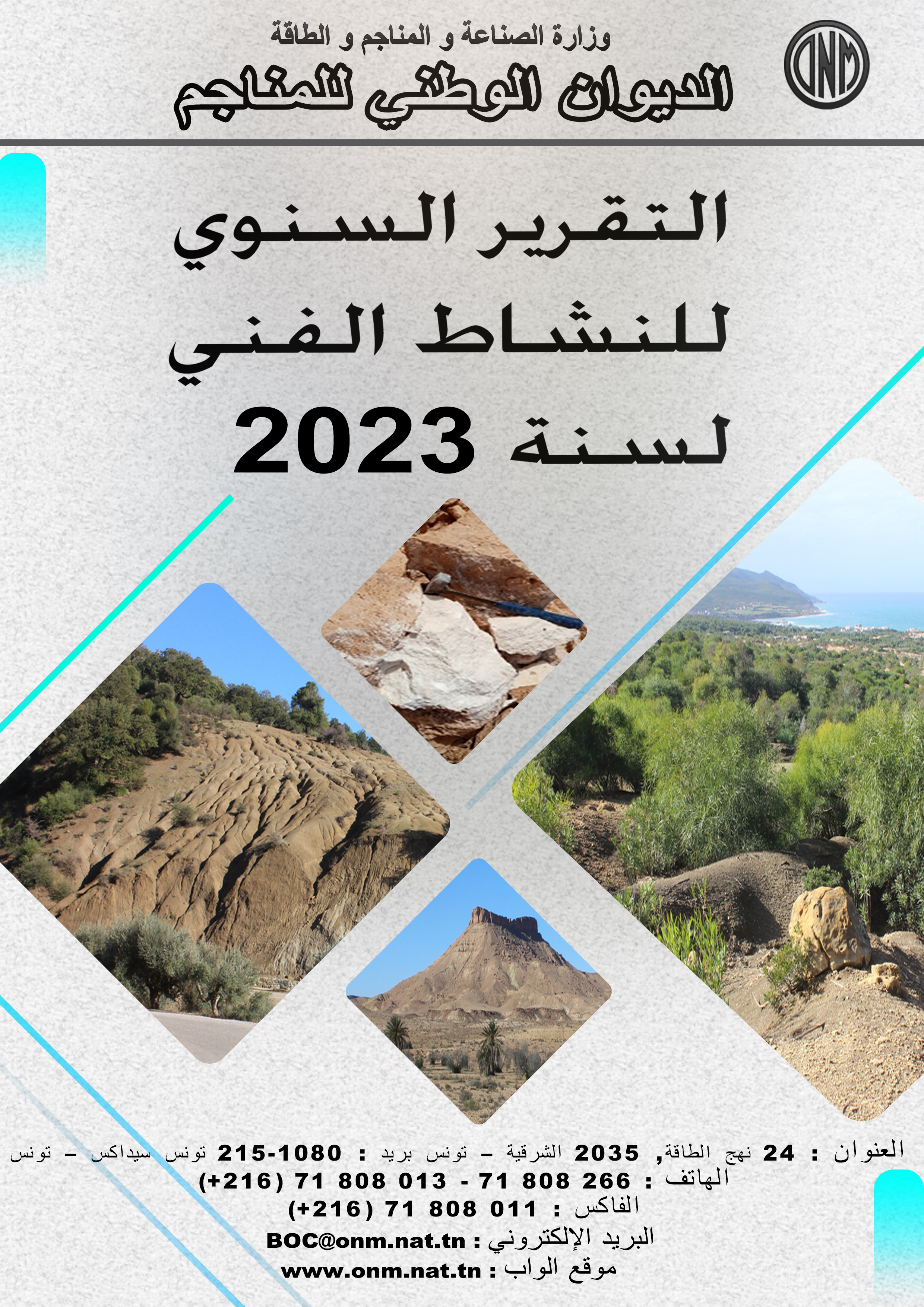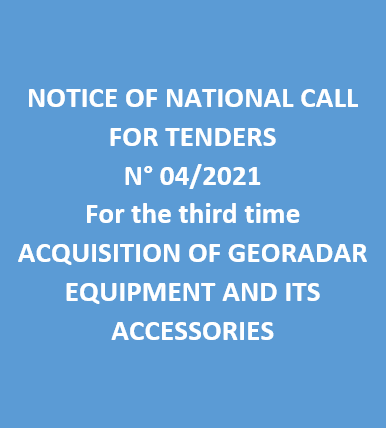| Annual program and technical progress report |
-

Technical Program 2025
-

Activity Report 2023
|
| Geocatalogue |

|
| Invitation to
tender |
-

REALIZATION OF THE TRAINING PLAN FOR THE YEAR 2022
-

ACQUISITION OF TWO SERVICE CARS
-

ACQUISITION OF GEORADAR EQUIPMENT AND ITS ACCESSORIES
|
|
Invest in Tunisia |

|
|
|
|
|
::
Documentation and Editions
>>
Research library
|
| |
|
[
Search by author
]
[
Search keyword
]
[
Search by index
]
[
Search by category
]
|
title of the reference :
|
Environmental and socio-economic impacts of erosion and sedimentation in north Africa.
|
|
Publication Date:
|
1996
|
|
Author :
|
Lahlou A., Walling D.E., Webb John S.
|
|
Catalogue type :
|
Livre
|
|
Catalogue reference :
|
(GBR) IAHS-AISH publ. Environmental and socio-economic impacts of erosion and sedimentation in north Africa. The increasing pace of water resource exploitation with the aim of developing water resources all over the countries of north Africa (Morocco, Algeria, Tunisia), brings with it a greater and greater need for a thorough knowledge (both in theory and in practice)of the widespread erosion of drainage basins, of the resulting transport of sediment, and of the silting-up of reservoirs. In north Africa, the high degree of climatic variability, the torrential nature of storm runoff, the low vegetation cover, and the excessive soil exploitation, have a great impact on erosion, sediment yield, and fluvial transport, on dam sedimentation and, consequently, on socio-economic conditions. An analysis of sedimentation data for 73 large dams in north Africa and of turbidity measurements at gauging stations, has been used to investigate relationships between sediment yields and basin area, dominant lithology and mean annual runoff: and to establish a series of formulae for predicting the rate sedimentation of dams before construction for various lithologies. In order to assist in the establishment of appropriate policies for reducing the negative impacts of erosion and sedimentation, through implementation of anti-erosive measures, existing methods are assessed and strategies to be adopted in the short, medium and long terms are reviewed in terms of both technology and legal and planning aspects. The analysis reported provides a contributionto the understanding and quantification of the complex factors associated with the erosion of drainage basins, the transport of sediment, reservoir siltation, and the environmental impact of these aspects, In north Africa, the need to develop improved models of sediment transport as well as of reservoir sedimentation is highlighted. The social, economic and environmental impacts of reservoir siltation in the short- medium- and long-term, as well the effects of sediment (particularly in drinking water reservoirs)on eutrophication, the stability of banks, and the risk of flooding caused by the rise in water level in rivers upstream from important north Africa large dams are also considered. The need to start to undertake multi-criteria and systematic economic impact studies, using a maximum number of parameters related to erosion, sediment transport and reservoir sedimentation, in order to demonstrate external losses due to such factors in corresponding analytical matrix inputs, is emphasized.
Ressource eau ; Drainage ; Bassin versant ; Réservoir ; Végétation ; Erosion fluviatile ; Transport sédiment ; Sédimentation fluviatile ; Barrage ; Turbidité ; Jaugeage ; Production sédiment ; Ruissellement ; Gestion ressource eau ; Taux sédimentation ; Eutrophisation ; Modèle ; Maroc ; Algérie ; Tunisie Walling D.E. Webb John S. Lahlou A. Géomorphologie, Pédologie
|
|
Indexation decimale :
|
Géomorphologie, Pédologie
|
|
Keywords :
|
Ressource eau ; Drainage ; Bassin versant ; Réservoir ; Végétation ; Erosion fluviatile ; Transport sédiment ; Sédimentation fluviatile ; Barrage ; Turbidité ; Jaugeage ; Production sédiment ; Ruissellement ; Gestion ressource eau ; Taux sédimentation ; Eutrophisation ; Modèle ; Maroc ; Algérie ; Tunisie
|
|
Summary :
|
The increasing pace of water resource exploitation with the aim of developing water resources all over the countries of north Africa (Morocco, Algeria, Tunisia), brings with it a greater and greater need for a thorough knowledge (both in theory and in practice)of the widespread erosion of drainage basins, of the resulting transport of sediment, and of the silting-up of reservoirs. In north Africa, the high degree of climatic variability, the torrential nature of storm runoff, the low vegetation cover, and the excessive soil exploitation, have a great impact on erosion, sediment yield, and fluvial transport, on dam sedimentation and, consequently, on socio-economic conditions. An analysis of sedimentation data for 73 large dams in north Africa and of turbidity measurements at gauging stations, has been used to investigate relationships between sediment yields and basin area, dominant lithology and mean annual runoff: and to establish a series of formulae for predicting the rate sedimentation of dams before construction for various lithologies. In order to assist in the establishment of appropriate policies for reducing the negative impacts of erosion and sedimentation, through implementation of anti-erosive measures, existing methods are assessed and strategies to be adopted in the short, medium and long terms are reviewed in terms of both technology and legal and planning aspects. The analysis reported provides a contributionto the understanding and quantification of the complex factors associated with the erosion of drainage basins, the transport of sediment, reservoir siltation, and the environmental impact of these aspects, In north Africa, the need to develop improved models of sediment transport as well as of reservoir sedimentation is highlighted. The social, economic and environmental impacts of reservoir siltation in the short- medium- and long-term, as well the effects of sediment (particularly in drinking water reservoirs)on eutrophication, the stability of banks, and the risk of flooding caused by the rise in water level in rivers upstream from important north Africa large dams are also considered. The need to start to undertake multi-criteria and systematic economic impact studies, using a maximum number of parameters related to erosion, sediment transport and reservoir sedimentation, in order to demonstrate external losses due to such factors in corresponding analytical matrix inputs, is emphasized.
|
|
Exemplaries :
|
-
|
|
|
|
|
|
|
|



